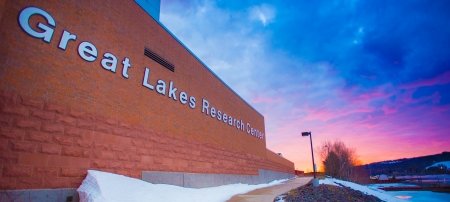New Satellite Maps Track Harmful Algal Blooms in Great Lakes

Satellites orbit our lives in so many ways. They beam our favorite TV shows to our living rooms, predict tomorrow’s weather, and tell us how to get where we want to go.
Now scientists from the Michigan Tech Research Institute (MTRI) are using satellite data to determine where harmful algal blooms (HABs) are proliferating in the Great Lakes and what threats they may pose to water quality and public health.
The project generates HABs maps of the Western Basin of Lake Erie, Saginaw Bay on Lake Huron and Green Bay on Lake Michigan. The maps show the location and extent of HABs in these waters, as well as areas of water quality and public health concern. Anyone can view the maps, which are updated weekly, by visiting www.mtrihabsmapping.org.
HABs develop when nutrients from agricultural runoff encourage the development of high algae levels that can clog water intake pipes, affect the quality of drinking water, potentially harm pets and make humans sick. Climate change is another factor in the proliferation of HABs. Algae thrive in warmer water, and the water temperature in the Great Lakes has risen significantly in recent years and continues to rise.
“These maps give unprecedented access to real-time data to inform stewardship decisions and promote sustainable ecosystem restoration and protection efforts,” said Robert Shuchman, co-director of MTRI and a lead scientist on the HABs satellite mapping project. “We are pleased to be working with the EPA’s Great Lakes National Program Office (GLNPO), the Great Lakes Observing System (GLOS), and the NOAA Great Lakes Environmental Research Laboratory (GLERL) on this important environmental issue.”
The data will be useful to commercial, sport and charter fishermen, sailors, tourists and public water system managers, Shuchman said. It will provide valuable information for beach managers. The general public will use it as well, he predicted. “You don’t want your grandkids going to the beach and jumping into pea soup.”
MTRI is a research center of Michigan Technological University and based in Ann Arbor, Michigan. One of MTRI’s specialties is developing and deploying remote sensing technologies such as the one that is mapping HABs. The work is presently funded by the US EPA Great Lakes Restoration Initiative (GLRI) under the direction of Beth Hinchey Malloy, as well as Jen Read of the GLOS.
Scientists working on the HABs mapping project include Shuchman; Mike Sayers, MTRI research engineer; Gary Fahnensteil, senior scientist at MTRI and Michigan Tech’s Great Lakes Research Center; Colin Brooks MTRI Environmental Laboratory manager, Dave Millie MTRI research scientist, Nate Jessee and Zach Raymer, assistant research scientists at MTRI; and George Leshkevich, physical scientist at NOAA/GLERL.
Michigan Technological University is an R1 public research university founded in 1885 in Houghton, and is home to nearly 7,500 students from more than 60 countries around the world. Consistently ranked among the best universities in the country for return on investment, Michigan's flagship technological university offers more than 185 undergraduate and graduate degree programs in science and technology, engineering, computing, forestry, business, health professions, humanities, mathematics, social sciences, and the arts. The rural campus is situated just miles from Lake Superior in Michigan's Upper Peninsula, offering year-round opportunities for outdoor adventure.




Comments